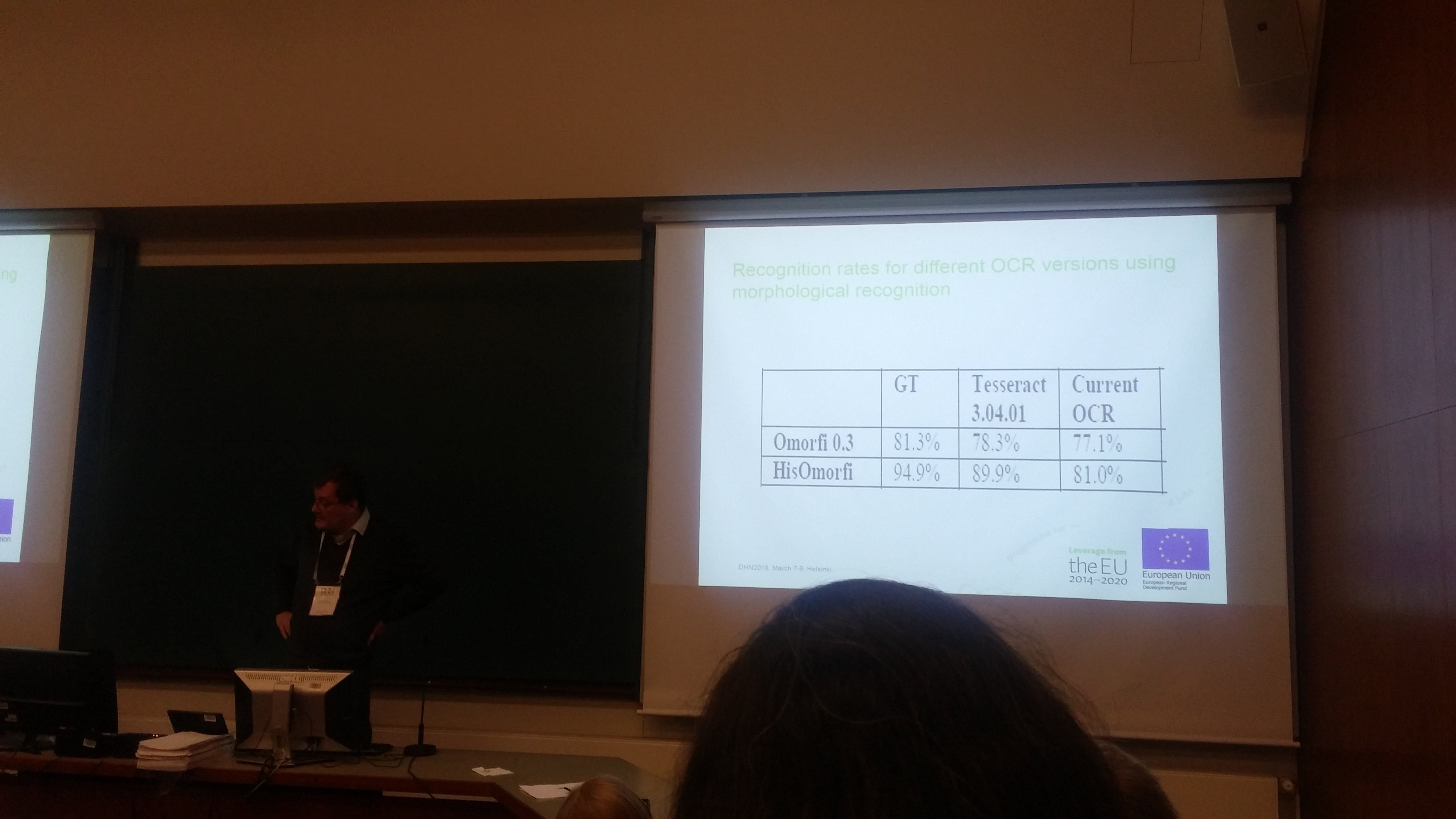Ensimmäinen Kansalliskirjaston tutkijapalveluiden sanomalehtisymposium järjestettiin 16.5.2019. Tällä kertaa keskityimme sanomalehtiaineistoihin, tarkoituksena saada kuvaa aineistojen käyttötavoista juuri nyt, nykyisillä sopimusmalleilla ja käyttöehdoilla. Tavoitteenamme oli kerätä tietoa mikä tilanne on nyt, mitä toiveita on, ja miten jatkossa tulisi varautua nykyisen lehtiaineistojen tutkimuskäytön suhteen. Halusimme saada mahdollisimman laajasti kokemuksia eri puolilta ja siksi kasvatimme seminaarin kestoa aiotusta, kun hyviä ehdotuksia tuli niin paljon, joista halusimme itse tietää ja antaa mahdollisuuden myös tutkijoille kuulla toisistaan, kun yhteisenä tekijänä on saman aineistokokonaisuuden osa – vaikka tutkimusaiheet ja -alat vaihtelivat teologiasta feminismin tutkimukseen, tai arkkiveisuista, liki nykypäivään.

Tie vapauteen, 01.09.1922, nro 9, s. 9
https://digi.kansalliskirjasto.fi/aikakausi/binding/1360361/articles/3278605?page=9
Kansalliskirjaston digitaaliset aineistot
Ylikirjastonhoitajan tervetuliaispuheen jälkeen, jossa korostettiin tutkimuksen tärkeyttä ja yhteistyötä aineistojen ja tutkijoiden kesken, pääsivät puhujat irti! Kansalliskirjaston omalla tutkimus- ja kehitystyön kertomuksilla aloitettiin, jotta päivä saatiin käyntiin ja kaikki paikalle. Digi.kansalliskirjasto.fi – palvelun uutuuksista mainittiin, kuten samana päivänä julkaistusta uudesta avauksesta. Kerrottiin myös Digitalia-projektin tuomista uutuuksista lyhyesti, mitä seuraavaksi julkaistaan, eli tekstintunnistuksen korjauksesta, artikkelinpoiminnasta, nimien poiminnasta ja kuvitusten luokittelusta, joita aletaan pian viemään tuotantoon kohdelehteen eli Uuteen Suomettareen ja toivottavasti siitä eteenpäin (hiljalleen) mitä prosessointiteho antaa myöten.
Digitalian Kimmo Kettunen kertoi tekstintunnistuksen korjauksista, joka on oleellinen vaihe ennen nimien poimintaa, jotta virheiden määrä vähenee. Tunnistus paranee, joka taas parantaa aineistojen löydettävyyttä. Kun yleisöstä kysyttiin mitä tutkimuksen jälkeen tapahtuu, niin Kimmo kertasi, Kansalliskirjaston DH-tutkimuksen ja aineistojen rikastamisen pääidean: “Proof is in the pudding”, eli ajatus on, että tutkimuksen tuotokset viedään tuotantoon ja aina Digi-esitysjärjestelmään saakka, jolloin tutkijat ja kansalaiset voivat yhtä lailla hyödyntää aineistoja tehokkaammin tai uusin keinoin, kumpaa sitten parempana pitääkään.
Juha Rautiainen kertoi kiinnostavasta NewsEye-projektista, jossa ajatus on viedä työkalukehitystä vielä eteenpäin. Tutkijat saavat uusia työkaluja, joilla prosessoida aineistoja ja joilla pääsevät nopeammin tutkimuskysymystään vastaavaan aineistoon. Näitä työkalujen ensimmäisiä versioita testattiin jo NewsEye-projektin omassa kokoontumisessa alkuviikosta, joten kehitys etenee sielläkin saralla.
Jussi-Pekka Hakkarainen paljasti tulevia suunnitelmia lehtiaineistojen tutkimuskäytön suhteen. Olemme saaneet tämän ensimmäisen pilotin aikana palautetta siitä, että miksi vain tietty tutkimusryhmä saa aineistot käyttöön, ja toinen naapurista ei, miksi vuosiraja on tietty, eikä jokin muu ja mitäs oikeastaan aineistoilla nyt sai tehdäkään? Näihin kysymyksiin, työnimellä Tutkain aloittanut neuvotteluprosessi pyrkii löytämään ratkaisuja hyvässä yhteistyössä tekijänoikeusjärjestön (eli lehtien oikeudenhaltijoiden) kanssa. Suunnitelmat ovat vielä hyvin alkuvaiheessaan, ja työ aivan alussa, joten kärsivällisyyttä ja positiivisia ajatuksia neuvottelijoiden suuntaan.
Varoitus: Alla oleva tulkinta esityksistä on kirjoittajan, esityksiä oli kuitenkin lukuisia, joten osa vivahteista on voinut jäädä huomaamatta, josta pahoittelut virheistä jo etukäteen. Ideoita tuli tulvimalla!
Sessio 1.
Historiallinen sanomalehtikirjasto on fantastinen!
Tarja Luukkanen toi mieleen ne kaikki tarinat, uutiset joita sanomalehtiainistosta löytyy. Kuinka esimerkiksi August Ahlqvist oli vuonna 1860 saanut suureelliset juhlat, ja sitten hautajaiset 1889 ja kuinka tämän jälkeinen sanomalehtikeskustelu nosti hänestä kansallista suurmiestä. Miten Topeliuksen tarina on luonut suomalaisen miehen prototyyppiä, jopa stereotyyppiä, josta ehkä ei vieläkään ole päästy täysin irti. Hienoa oli kuulla tällaisestä pitkäaikaisesta tutkimuksessa, jossa edetään systemaattisesti aineiston parissa!
Toiveina: lehtien “luokittelu”, eli mitä puoluekantaa lehdet olivat (esimerkiksi hyödyntäen Suomen sanomalehdistön historian -teossarjassa jo olevaa tätä tietoa), lehden levikki ja agenda.
Lehdistössä julkaistuja paikalliskirjeitä kokoava Translocalis-tietokanta Heikki Kokko (Tampereen yliopisto): kertoi kuinka aineistokoelmansa, joka on tehty digin perustoimintojen avulla on edennyt siihen vaiheeseen, että pallo heitetiin kohti Kansalliskirjastoa ja miettiä kuinka leiketoimintoa voisi hyödyntää eteenpäin. Lehtileikkeet ovat olleet yllättävä menestys ja hyvä tapa tutkijoille kerätä tutkimusaineistoa talteen.
Biografinen materiaali ja sen löytäminen Kaisa Kyläkoski, esitti kiinnostava katsaus henkilöhistoriaan ja samalla sai kuvaa mitä kaikkea suositun bloginsa taustalla tapahtuu (lyhyesti sanoen). Hän on ollut palvelun parissa jo vuodesta 2004, joten matkan varrella hän on voinutkin havaita kuinka palvelu on hiljalleen muuttunut. Kaisalta taisikin tulla kiitos niinkin perustoiminnosta kuin hakutulosten järjestämistä kronologisesti, joka oli yhden hänen kirjaprojektinsa näin pelastanutkin. Hän oli myös konkreettisesti kokenut nimien löytämisen vaikeuden – kuinka tekstintunnistuksen virheet tai jopa välimerkit voivat haussa aiheuttaa yllätyksiä, mutta toisaalta myös uusia löytöjä.
”Maaseudun tulevaisuus on ihan loistava aineisto”
Digitoitu lehtiaineisto ja historiantutkimus: kokemuksia ja kehittämiskohteita Hannu Salmi (Turun yliopisto), kertoi useammastakin projektista joissa tutkimusryhmänsä on sanomalehtien kanssa työskentelemässä. Yksi näistä on tuttu Comhis, jossa Kansalliskirjastokin on mukana, tämän lisäksi kuulimme myös mannerten yli ulottuvusta tutkimuksesta nimeltään OceanicExchanges, jossa viedään tutkimusteemoja vielä laajemmalle, globaaleihin uutisiin ja niiden leviämiseen. Ovelaa oli se, että samanlaisten geeni, tekstipätkien etsinnässä pystytään osin kiertämään tekstintunnistuksen heikkoudet ja virheet, jolloin pystytään löytämään kuinka uutiset ovat siirtyneet lehdestä toiseen ja ajassa eteenpäin. Ovatko aikansa kirjoittajat arvanneet, että aika merkittävä määrä artikkeleita on ilmestynyt myöhemmissä lehdissä uudestaan, 10 , 20, 40, tai jopa 100 vuoden kuluttua?
Tässä puheessa tuli myös esille se, että on myös arvokasta, että joitakin lehtiä on olemassa koko julkaisuhistorialtaan – tällöin tiettyjä teemoja (esimerkiksi ilmastoon liittyviä) voidaan seurata systemaattisesti lehden sisällön kautta. Pääetenemä digitoinnissa menee vuosittain, ja yksittäisiä lehtiä on tehty digitointikumppanuuksina, joka on mahdollistanut näiden muutaman lehden osalta kattavan katsauksen – tällöin on luonnollista, että näihin harvinaisuuksiin, jotka ovat helposti käytettävissä koko julkaisuhistorialtaan, että ne saavat huomiota tutkijoilta.
Vaka, vanha mikrofilmi!
Päivän aikana tuli myös kiitosta mikrofilmeille – sekin on kuitenkin tapa välttää paperiseen originaaliin tarttumista, sivujen selailu kuitenkin onnistuu (ja aineiston talletus omalle tikulle) vaikka hakua ei olekaan. Mikrofilmit ovat kuitenkin kattavasti lehdille tehty, säilytystavoitteiden saavuttamiseksi. Eräälle kysyjälle korjaukseksi näin jälkikäteen, lehdet ovat Pohjoissalissa saatavilla vuoteen 1945 ja tätä tuoreemmat tulee tilata etukäteen. Syynä tähän, että tila on salissa kuitenkin rajattu, joten käytetyimmät lehdet löytyvät valmiina, eli joitakin lehtiä löytyy myös pidemmälle. Lista lehdistä ja ohjeita mikrofilmien tilauksesta löytyy verkkosivultamme ja mikrofilmiskannerin käytöstä on myös ohjevideo.
https://youtu.be/1VSULRUVUTQ
Päivän pohdinta jatkuu seuraavassa blogikirjoituksessa…



